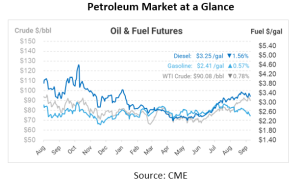
10 Ways to Optimize Your Fuel Program: Part 1
Fuel managers are constantly looking for ways to deliver innovations in their business – whether that’s to reduce costs or make operations simpler. But unfortunately, there’s no manual on how to make fuel easier – until now. Exploring the different tools and strategies can help you fine-tune your fuel program and uncover significant cost savings and operational improvements.
This article focuses on ten useful methods for efficiently managing and reducing your fuel expenses. We’ll divide the topic into two parts, with this being Part 1, covering the first five strategies. In our next article, Part 2, we’ll discuss the remaining five strategies. Stay tuned!
- Fuel Centralization
Fuel centralization is all about bringing together your fuel program under one roof. When you centralize your fuel procurement, you can tap into best practices used throughout the industry. This means you’re not reinventing the wheel; you’re benefiting from what works best. Additionally, centralization allows you to make the most of your purchasing power. By buying in larger volumes, you can negotiate better deals and drive down costs. Ultimately, the goal of fuel centralization is to trim down your overall fuel program expenses while gaining better control over every aspect of fuel management, from procurement to delivery. Whether you’re managing multiple sites or a single facility, centralization can make a significant difference in optimizing your fuel program.
- Inventory Management
Inventory management is a foundational element for fuel programs, offering many benefits. By leveraging the capabilities of fuel providers to manage your inventory, you gain round-the-clock access to fuel levels and ensure timely supply based on agreed reorder points. This not only provides real-time visibility into your fuel inventories but also eliminates the need for manual checks, especially in adverse weather conditions or unsafe environments. Efficient inventory management allows you to maximize fuel load sizes, minimize freight charges, and reduce risks associated with fuel shortages or excess stock. Additionally, it paves the way for strategic decision-making by providing valuable data insights into consumption patterns, ultimately contributing to cost savings and operational optimization.
- Back Office Automation
Back Office Automation allows you to streamline your AP and reduce the issues associated with administrative tasks. By automating the invoicing process, you eliminate the need for manual handling and reduce the chances of errors. This not only saves valuable time but also lightens the load on your back-end team. Imagine not having to chase invoices or deal with discrepancies regularly! Also, it allows you to efficiently manage your data and ensure it’s always up to date. This digital transformation isn’t
just about hard savings; it’s about making your entire operation smoother and more efficient, freeing up your team to focus on more strategic tasks.
- Fuel Tank Optimization
Installing bulk tanks can yield significant cost savings, with the potential for positive ROI in as little as one to two years for facilities consuming 7,500 gallons of fuel or more per week. It’s crucial to consider asset depreciation as well, as tanks become long-term assets that continue to provide financial benefits. Therefore, reduced delivery costs, enhanced fuel security, and even environmental advantages make fuel tank optimization an excellent move for businesses seeking both financial and operational efficiency.
- Fleet Cards
While converting from retail cards to bulk tanks can be a big financial saver, sometimes it’s simply not feasible to install a tank. Fleet cards are a great strategy for those looking to streamline fuel expenses and enhance efficiency. Different cards offer unique benefits – according to the geographic area where the fleet is located – and can be tailored to specific needs, which can result in substantial savings. By eliminating unnecessary card fees, reducing monthly transaction costs, and maximizing retail discounts, you can significantly reduce your overall fuel expenditure. Fleet card optimization not only cuts costs but also simplifies fuel management by consolidating billing and providing a comprehensive view of fuel expenses.
Stay tuned! Part 2 is coming up on Thursday. We’ll explore five other strategies to optimize your fuel program, covering topics like ensuring fuel quality and efficient R&M programs. These insights will help you improve your fuel management and save costs. You cannot afford to miss it!

This article is part of Daily Market News & Insights
Tagged:
MARKET CONDITION REPORT - DISCLAIMER
The information contained herein is derived from sources believed to be reliable; however, this information is not guaranteed as to its accuracy or completeness. Furthermore, no responsibility is assumed for use of this material and no express or implied warranties or guarantees are made. This material and any view or comment expressed herein are provided for informational purposes only and should not be construed in any way as an inducement or recommendation to buy or sell products, commodity futures or options contracts.





